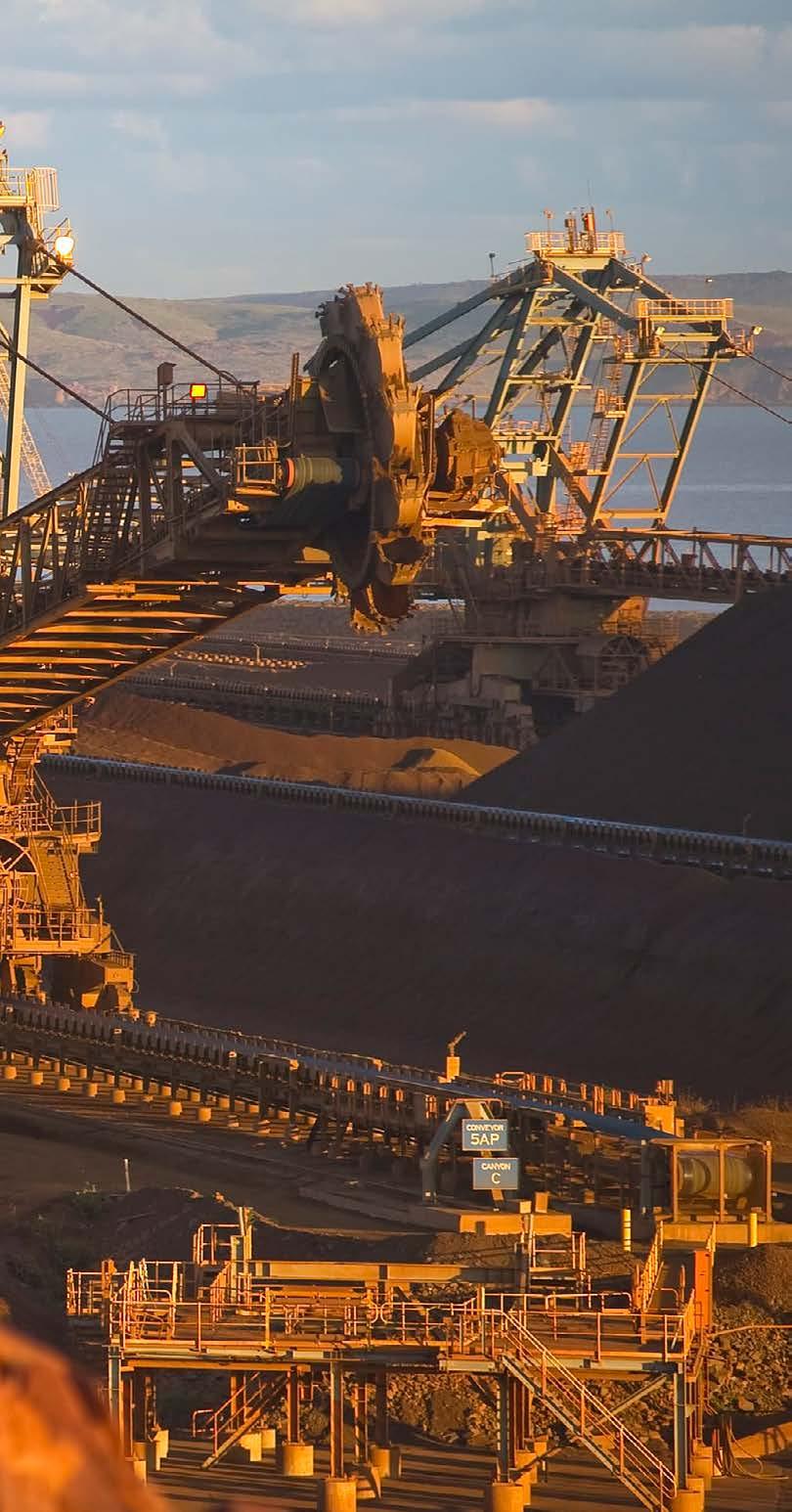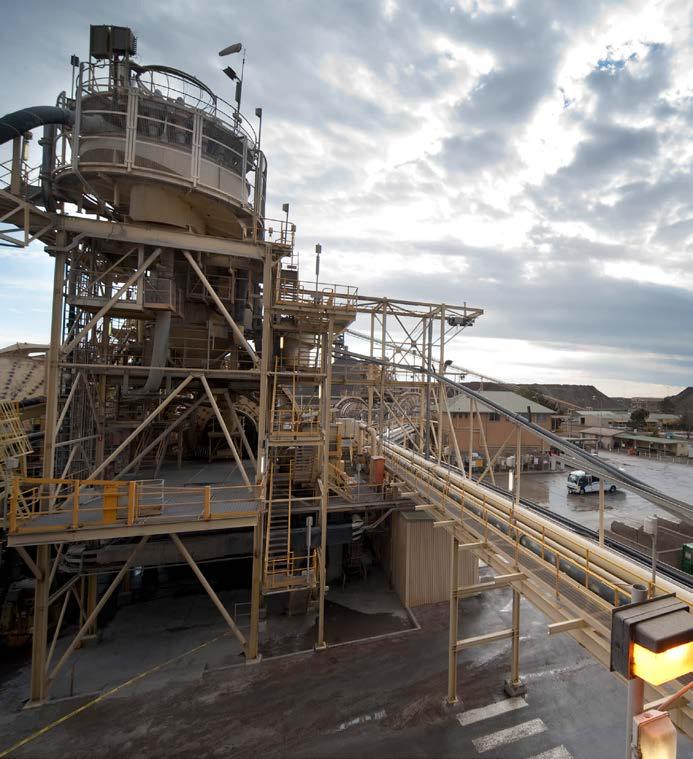
5 minute read
Rio iron ore industry is in a healthy state
With the miners signaling that it could capitalize on stratospheric iron ore prices by shipping record volumes of the steel-making commodity this year, Rio Tinto's biggest profit in nine years could be just the beginning.
The largest iron ore miner in Australia is on track to post a full-year underlying profit of nearly US$12 billion next month, but with iron ore prices 76 percent higher than the average price received by Rio over the past year, the record US$15.5 billion profit set in 2011 appears to be vulnerable in the coming year.
While demand from other Asian markets was recovering from pandemic lockdowns, Rio said Chinese buying patterns remained strong, creating boom conditions despite trade tensions between Australia and China.
Peter O'Connor, Shaw and Partners analyst, said that if iron ore prices stayed at the price of $US174.07 per tonne on Monday night for the rest of this year, Rio would almost double its best ever result with earnings of more than $US29 billion. But Rio warned investors that while record exports of iron ore were possible in the year ahead, an increased focus on indigenous heritage following the Juukan Gorge scandal last year and difficulties with the delivery of new mines within the hard border of Western Australia could hamper export rates.
Rio said that between 325 million and 340 million tonnes of iron ore would be shipped in 2021.
That target range straddles last year's 330.6 million tonnes shipped by Rio from Western Australia, but implies that there is more room for growth than a reduction in production.
GLOBAL

never done better than the 338.1 million tonnes shipped in 2018, but the guideline range on Tuesday means that if everything goes to plan, the record could fall.
RISKS EMPHASIZED
Australian iron ore miners' export targets are always subject to weather, given that the bulk of the nation's production comes from the cyclone-prone Pilbara region of WA.
But Rio put a couple of additional qualifiers on its 2021 export target. "Iron ore guidance takes into account the risks associated with tying in approximately 90 million tonnes of replacement mine capacity,'' Rio said in a statement. "The future impact on our Pilbara iron ore operations, mine developments and heritage approach from the reform of the Aboriginal Heritage Act 1972 (WA) remains unknown.''
Rio's relationship with the traditional owners of Puutu Kunti Kurrama and Pinikura has been severely tested by the destruction of the Juukan Gorge, and Rio has pledged to implement a permanent moratorium on mining around the gorge as part of efforts to heal the relationship.
IMPACTS OF REGULATIONS
On Tuesday, Rio was not explicit as to what impact a permanent moratorium would have on the nearby iron ore mine Brockman 4. Last year, Goldman analyst Paul Young speculated that the Juukan Gorge regulatory response could be a watershed moment for the resource industry, leading to weaker growth in future exports.
But Rio stressed that throughout its iron ore division, it had a lot of flexibility, which should allow it to cope with any needed modifications to mine plans.
In its mining divisions, Rio has placed responsibility for heritage management, saying that product groups such as the WA iron ore division would have primary responsibility for engagement with communities and stakeholders.
In the final three months of 2020, Rio shipped 88.9 million tonnes of iron ore from Western Australia, a result that was slightly better than expected.
The strong end of the year means that Rio has reached the export target it set at the beginning of 2020.
After cyclones hit WA in February 2020, that target was downgraded, but Rio recovered to sneak into the bottom end of its original guidance range.
EFFECTS FROM CHINA
Import data from China suggests that strong demand from the Asian superpower may have been a bigger factor than Brazilian export weakness in the recent iron ore price strength.
China's imports of iron ore rose by 9 per cent to a record 1170 million tonnes in 2020. The additional 101 million tonnes imported by China last year may overshadow Brazil's 2020 decrease in exports of iron ore. When it sold 365.5 million tonnes of iron ore products, Vale achieved record exports in 2018.
In the immediate future, UBS analysts said there was no sign of iron ore prices softening, with steel demand strong,
Chinese steel exports resuming, and the risk of further supply disruption in Brazil following a fire last week at a major iron ore port. Sales and shipment information will be reported by Brazilian miner Vale later this month, but its sales slump is not expected to exceed 100 million tonnes.
“In China the industrial sector has recovered and is now at pre-COVID levels due to the rapid deployment of stimulus.” — Rio Tinto statement
Rio said Chinese iron ore buying remained robust while demand in other markets such as Japan, Korea and Taiwan was recovering from lockdowns.
''In China the industrial sector has recovered and is now at pre-COVID levels due to the rapid deployment of stimulus,'' Rio said on Tuesday. ''A policy shift to promote domestic investment and consumption is supportive of the commodity demand outlook."
While the iron ore price boom is auguring well for Australia, prices are also encouraging miners and steelmakers to look for new iron ore options in other countries, and Rio has confirmed that its Simandou iron ore tenements in the African nation of Guinea have resumed activity.


"Activity at the mine area is starting including roadworks,'' Rio said on Tuesday. Rio said that before June 30, it wanted to complete a review of the infrastructure requirements for the project, including 650 kilometers of new railway.
This review will help inform Rio of the negotiations in the Simandou Mountains with neighboring iron ore aspirants.
Last year, former Rio chief Jean-Sebastien Jacques pointed out that the high infrastructure costs of getting Simandou's iron ore into the seaborne markets ensured that working together on infrastructure could make sense for the various miners in the region.










